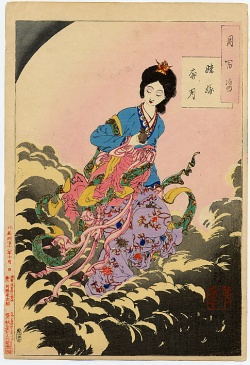Chang E 嫦娥
Chang E 嫦娥, also called Heng E 姮娥 or Su E 素娥, is a mythological person. In the book Huainanzi 淮南子 she is called the spouse of Hou Yi 羿, who had begged the herb of immortality from the Queen Mother of the West 西王母. Before he was able to consume it, Chang E stole the drug, became an immortal and ascended to the moon. She became there the "spirit of the moon" (yuejing 月精) or goddess of the moon (yueshen 月神) and took there she shape of a toad (chanchu 蟾蜍). This is the most famous story about her. In the Shanhaijing 山海經 it is told that Chang Xi 常羲 was the wife of Emperor Jun 帝俊 (Di Ku 帝嚳) and used to bath the twelve moons she had given birth to. The Lüshi chunqiu 呂氏春秋 calls her the inventor of divination by the moon (zhan yue 占月). A lost chapter in the Da Dai Liji 大戴禮記 said that Chang Yi 常儀 (or Shang Yi 尚儀) was the daughter of Ju Zi 娵訾, wife of Emperor Di Ku. The oldest book mentioned in which Chang E appears, is the lost text Guicang 歸藏, quoted in a commentary to a poem in the anthology Wenxuan 文選. It is said that the brightness of the moon is so powerful that it is able to revive the death, an imagination that often appaers in Chinese stories.
The story of the toad and the rabbit in the moon can be led back to a phonetic error. Wen Yiduo 聞一多 found out that the word gutu 顧菟(兔) "admiring the rabbit" or "gazing rabbit" mentioned in a verse of the elegy Tianwen 天問 of the collection Chuci 楚辭 "Poetry of the South" is phonetically the same as chanchu "toad", so that from the Han period 漢 (206 BCE-220 CE) on, following Wang Yi's 王逸 commentary, there is word of two animals in the moon, a rabbit and a toad. The book Huainanzi deducts a lunar eclipse from the appetite of the toad that devours the moon. The book Guicang identified the toad as the "lunar spirit", while the Huainanzi says that the "spirit of the moon" was a crow.
The name of Chang E or Heng E should actually be written with the character 恒 "eternal, ever-lasting", but this character was regularly replaced with the character 常 in order to avoid the personal name of Emperor Wen 漢文帝 (202-157, r. 180-157 BCE) of the Han dynasty, Liu Heng 劉恒. Hong Yixuan's 洪頤煊 commentary to the Huainanzi also says that the character 姮 is a post-Han invention, just like 嫦 instead of 常.
In some stories, Chang E is accompanied by another lunar girl called Qing Nü 青女 "Green Girl".
Source:
- Yuan Ke 袁珂 (ed. 1985). Zhongguo shenhua chuanshuo cidian 中國神話傳說詞典, pp. 87, 304, 310, 354, 424, 448. Shanghai: Shanghai cishu chubanshe.
